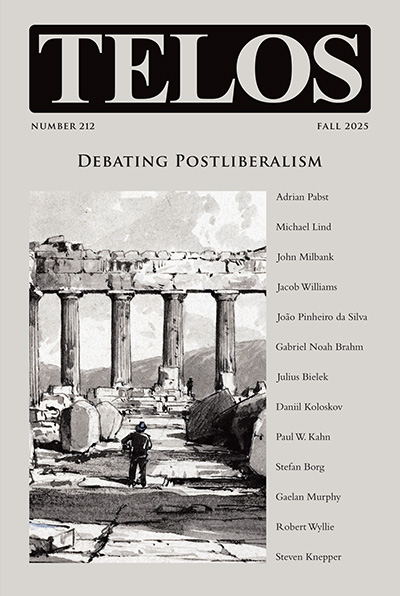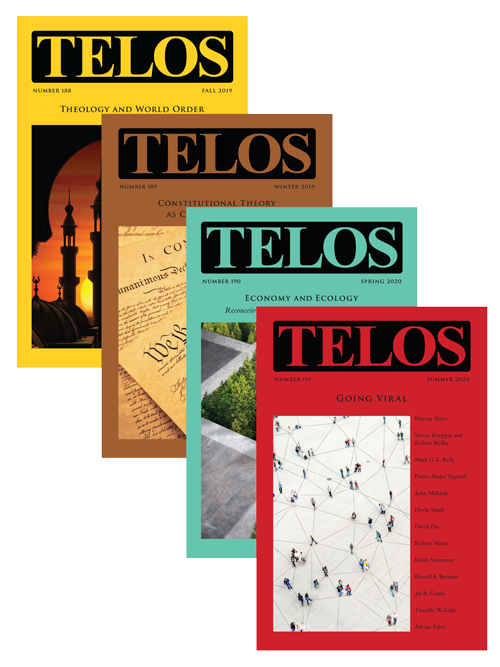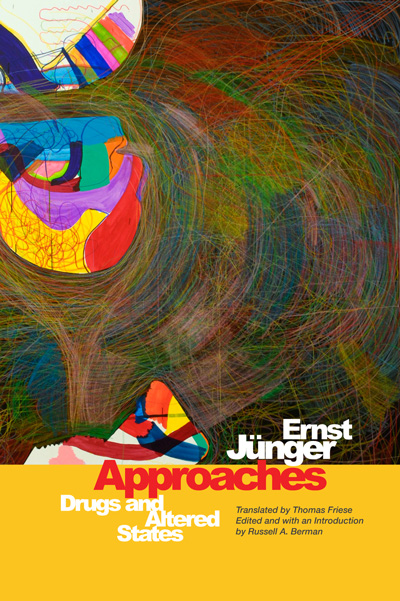Telos 211 (Summer 2025): Dispatches from the Culture Wars is now available for purchase in our store. Individual subscriptions to Telos are also available in both print and online formats.
 As we survey the landscape of war today, it has become truer than ever that hot wars are a consequence of culture wars. Trump’s support for Israel against Iran contrasts with the discourse on college campuses that opposes Israel as a white supremacist, settler-colonial state. In opposing the most egalitarian liberal democracy in the Middle East, this left-wing perspective poses a major threat to the liberal values that the United States has always stood for. But the anti-Israel protests at colleges represent only the tip of the iceberg of a more widespread form of hierarchical rule that has established itself globally through a “new class” of managers. Looked at in this way, the culture war at U.S. universities will have far-reaching consequences for the future of the world. At stake are not merely research funding and tax breaks, but a social structure that privileges expert opinion over popular rule in all areas of our society. Colleges and universities are the key to this system, as the social sciences train the professionals that go on to manage the lives of the uncredentialed, while the humanities develop the perspectives that justify this form of managerial rule. In this issue of Telos, we consider how today’s culture wars over universities will shape the global future.
As we survey the landscape of war today, it has become truer than ever that hot wars are a consequence of culture wars. Trump’s support for Israel against Iran contrasts with the discourse on college campuses that opposes Israel as a white supremacist, settler-colonial state. In opposing the most egalitarian liberal democracy in the Middle East, this left-wing perspective poses a major threat to the liberal values that the United States has always stood for. But the anti-Israel protests at colleges represent only the tip of the iceberg of a more widespread form of hierarchical rule that has established itself globally through a “new class” of managers. Looked at in this way, the culture war at U.S. universities will have far-reaching consequences for the future of the world. At stake are not merely research funding and tax breaks, but a social structure that privileges expert opinion over popular rule in all areas of our society. Colleges and universities are the key to this system, as the social sciences train the professionals that go on to manage the lives of the uncredentialed, while the humanities develop the perspectives that justify this form of managerial rule. In this issue of Telos, we consider how today’s culture wars over universities will shape the global future.
In his essay, Adam Webb establishes the global framework for understanding the role of universities in the world today by describing the global shift toward a managerial “new class” that rules over the rest of society. With the rise of higher education as a meritocratic institution, Western countries have established a hierarchical society that resembles the Chinese bureaucratic system Karl Wittfogel labeled as “oriental despotism.” Because an increasing share of the economic, educational, and political elite graduates from this unified system of higher education, alternative centers of power erode. Culturally, this new class espouses a “secular theodicy” that replaces religious and national traditions with a focus on individualism and upward mobility. Politically, the new class favors managerial solutions that are carried out by educated elites with a focus on protecting and extending life rather than on the meaning of life. Consequently, the primary ideologies of the new class revolve around climate change, public health and safety (as exemplified during the pandemic), and inclusion (as an individualist substitute for traditional culture), all of which justify the expansion of new class bureaucracies to manage the unwitting masses. Webb describes this modern form of oriental despotism not so much as an expansion of a Chinese model as a convergence of Anglo-American neoliberalism, European social democracy, and Chinese bureaucratic socialism toward the same model of new class governance.
As an alternative to university education, social media has become a source of ideas and ideology, perhaps displacing traditional education and media as the primary way in which attitudes and opinions develop. In their analysis of Chinese social media, Xue Ranran, Alexandra Bocharova, Alexander Lukin, and Olga Puzanova trace the rise of the Chinese view of Russia as the “warrior nation.” While the term itself was popularized by Chinese fans of the Japanese anime series Dragon Ball Z, its application to Russia began in the early 2010s and it gradually spread in Chinese social media, in spite of some attempts by official media to suppress it. Promoting a stereotype of Russians as courageous, aggressive, and tough, the term has coincided with a growing sense of solidarity with Russia as another opponent of the West. It remains unclear, though, whether social media represents a disruptive alternative to higher education as a shaper of culture or whether it in fact forms a more pervasive and surreptitious means of managing popular opinion.
The idea of academic freedom has served as a key ideological tool for the new class, as the idea has expanded from the defense of free speech to a more general defense of university academics’ right to be free from outside influence in defining the goals of their teaching and research. The discussion of academic freedom is thus central to an understanding of the modern transformation of society, and I would like to thank Salvatore Babones for organizing a conference on academic freedom and collecting the resulting essays for this issue of Telos.
In the first of these essays, Mark G. E. Kelly argues that diversity, equity, and inclusion (DEI) are not simply a set of discrete policies but part of a larger ideological framework that works to justify the privileges of a ruling class of high-paid managers. By shifting attention to diversity as an end itself, the ideology of DEI establishes a notion of ultimate values that displaces any other understanding of truth at the university as well as any other critique of existing meritocratic hierarchies in a variety of social and economic institutions. These two aspects of DEI—the normative dimension that grounds much university teaching and research today and the ideological dimension that supports an existing institutionalized professional-managerial power structure—combine to create a practically impregnable resistance to all attempts to dismantle it. Intellectual attempts to oppose diversity, equity, and inclusion as normative values can be denounced as not just wrong but morally evil, leading defenders of DEI to forbid any criticism of it in academic discourse. More broadly, in his own articulation of Paul Piccone’s artificial negativity thesis, Kelly argues that DEI provides existing institutions with “a noble cause by which to justify their baser and more central concerns.” DEI allows elites to promote ethnic minorities as a way of deflecting criticism from the more fundamental division between managers and the managed. Ultimately, DEI will remain powerful because it is part of an overarching ideological and institutional framework that establishes a system of values buttressed by embedded institutional interests.
Salvatore Babones suggests that academic freedom has always had an ambiguous significance in that it has been used to defend free speech but also to establish the authority of disciplinary knowledge. As he points out, the contemporary notion of academic freedom developed during the twentieth century and consequently coincided with, and was driven by, the establishment of today’s undergraduate majors and their corresponding academic disciplines. While the 1915 statement of academic freedom by the American Association of University Professors (AAUP) was more expansive, subsequent statements in 1925 and 1940 limited academic freedom to a professor’s disciplinary area of expertise. This restriction has tended to increase the power of the disciplines over the freedom of individual professors who might challenge consensus views, as Babones notes in the attempts to silence those who tried to express views that contradicted public policy during the pandemic. Moreover, while the tenure system in the United States and Canada provides relatively strong protections for professors with diverging views, academic freedom is not well protected in other parts of the world where the tenure system does not exist and where academic freedom depends on customs and legislation.
Emma Baillie describes the way in which academic freedom is in danger today because of the extreme polarization that has led some academics to exclude opposing, unorthodox views as unworthy of discussion, often because such views are held to be racist or sexist. This environment leads those who hold such views to hide them, thus undermining open debate about significant issues in which real divides often exist outside academia but go unrecognized within it. In order to foster an exchange of opposing viewpoints, Baillie suggests a mode of discussion in which each party does not try to persuade the other but instead simply lays out their own view as well as their understanding of the opposing perspective. In addition, she suggests a model of adversarial collaboration in which two writers with opposing views work together to produce one essay, thus challenging each other to find common ground.
Katy Barnett and Bill Swannie argue that academic freedom is an individual right that society should protect in order to maintain the role of universities as places for the pursuit of knowledge. They provide examples of how university administrations restrict or undermine academic freedom in order to maintain their own brand image. As a corrective to this pressure on universities to restrict academic freedom, they lay out a framework in which academic freedom might be established as a legal right that can be enforced against university administrations by allowing individuals to sue.
In their review of data from surveys and reports of specific incidents in New Zealand, James Kierstead, Michael Johnston, Stephanie Martin, and Max Salmon conclude that both students and professors are hesitant to state their opinions on a variety of contemporary issues, especially those surrounding gender, race, and the Treaty of Waitangi. They argue that the main threats to academic freedom stem from radical progressivism, the Chinese Communist Party, and the increasing market orientation of university administrators.
In our ongoing discussion of the Trump administration, we include several contributions that explore the meaning of the current conflict between the new administration and universities.
As Salvatore Babones argues, Trump’s attack on U.S. universities marks the end of an era of cultural policing to enforce a diversity, equity, and inclusion agenda and the beginning of a full-blown culture war. While this culture war appears on the surface as a conflict between a “woke” agenda that seeks to privilege certain gender and racial groups on the one hand and an ideal of equal opportunity on the other, the conflict goes much deeper. Campus antisemitism is only a small part of the ideological conformity around diversity, equity, and inclusion, as well as the broader faith in a managerial class that is viewed as the voice of reason against the imputed prejudices and irrationalities of the MAGA movement.
Mark G. E. Kelly cautions that the Trump administration’s attack on DEI will face formidable resistance due to its centrality as an ideological support for the managerial class, which dominates not just universities but the private sector as well. The larger issue for Kelly is the extent to which Trump will be aligned with an accelerationist agenda that pushes a technological transformation that would eventually marginalize state power in relation to a new world of AI supremacy. The alternative of a decelerationist restoration of national identity in a citizen republic seems for Kelly to be more an outdated fantasy than a concrete possibility. But to the extent that the accelerationist dream also aligns with a managerial vision linked to the ideologies of climate change, public health, and DEI that the MAGA movement has been attacking, there seems to be a much more serious fight than Kelly allows.
Jay Gupta sees Trump’s attack on universities and government agencies as a form of barbarism that denigrates both research and culture. He contrasts this attack with Al Gore’s successful rationalization of government bureaucracy during the Clinton administration, which was carried out as an attempt to refine and improve, not to disrupt. The unanswered question, however, is whether the goods of research, culture, and efficiency are meant to be the preserve of government or whether these goods might be achieved through the return of these spheres to private hands, in which competition allows for freedom and individual choices.
Tim Luke highlights the way in which the breathtaking cascade of initiatives in Trump’s first one hundred days has had a profound media impact. Whether it is the attack on universities, the DOGE “chainsaw,” the tariffs announcements, or the Oval Office tiff with Volodymyr Zelensky, Trump has always had an eye for what makes for “good television,” and Luke suggests that a key conflict today might be the one between university culture and popular culture.
My own contribution discusses the ways in which academic freedom has become part of the ideological superstructure of university faculty attempting to protect their privileged status. Rather than promoting freedom of speech, the defense of academic freedom today functions to exclude conservative, pro-liberal democracy perspectives and entrench a hierarchical structure of society. Consequently, the attack on academic freedom is not a barbaric turn against culture and rational thought but rather an attempt to democratize learning and knowledge. To the extent that the Trump administration continues to receive popular support in its struggle against universities, the conflict over academic freedom will remain central to the future development of U.S. politics and society.
David Pan is Professor of European Languages and Studies at the University of California, Irvine, and has previously held positions at Washington University in St. Louis, Stanford University, Penn State University, and McKinsey and Company. He is the author of Primitive Renaissance: Rethinking German Expressionism (2001) and Sacrifice in the Modern World: On the Particularity and Generality of Nazi Myth (2012). He has also published on J. G. Herder, Heinrich von Kleist, Friedrich Nietzsche, Franz Kafka, Walter Benjamin, Ernst Jünger, Bertolt Brecht, Carl Schmitt, and Theodor Adorno. He is the Editor of Telos.



